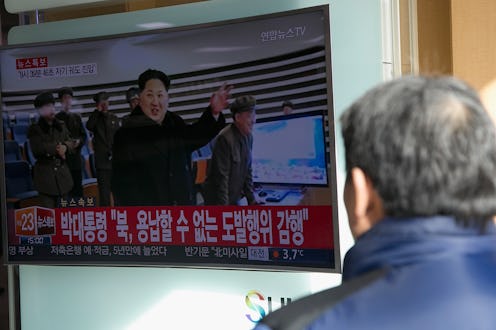News
North Korea Has Made Progress On Its Missiles

There are uncomfortable questions coming from the Korean peninsula after North Korea test launched what could have been an intercontinental ballistic missile (ICBM) Sunday. The North accompanied the test with some propaganda, in the vein of "historic significance" and "great victory." That might be a little much, but South Korea did confirm its significance. "Through this test, it is found that engine function has made meaningful progress," Lee Jin-woo, a spokesperson for the South's Department of Defense said Monday. A bit scary, to say the least. Given that progress, when will North Korea have a missile that reaches America?
Now might be the time to worry. The public doesn't know exactly when North Korea could have a missile ready to reach the United States because it doesn't know exactly what they tested on Sunday. It remains unclear whether the test was for a missile or for a rocket that would launch satellites into space (also something they're not supposed to do). South Korea said that they couldn't tell. Either way, the test could put the North one step closer to sending a rocket to the United States — and that was before Rex Tillerson's dramatic words Friday about a preemptive strike.
Before this most recent launch, Foreign Policy published a helpful guide that shows the potential range of North Korea's missile arsenal. Only the U.S. island territory of Guam has been thought to be within range before. The missiles previously tested had a maximum range of about 2,175 miles, which wouldn't even send them to Alaska or Hawaii. But there are missiles that the country hadn't tested (at least not before Sunday) that reportedly reach about 7,500 miles. If North Korea had one of those, that would put nearly the entire country in range.
Luckily, even a perfectly functioning missile is not enough (and the country probably doesn't have that either). If North Korea wants to cause massive damage in the United States, they need to do a bit more work. On top of the ICBM, they need to have a nuclear warhead that is small enough to fit on a missile. There are some reports that the North has one, but this isn't verified. Then they need to make it fly correctly on the missile. All of that together is an engineering challenge.
Particularly difficult is the engineering to help the missile reenter the atmosphere when it reaches its target. Kim Dong-yub, a South Korean expert on rocket engineering, told Reuters this is likely what will hold back the North. He said they need to finish work on other stages, and that they would show that piece by piece to draw attention. "They are not going to show it all at once," Kim told Reuters.
None of this is great news, but hopefully it does provide more time for Tillerson and the State Department to negotiate something that would avoid a preemptive strike or military intervention.